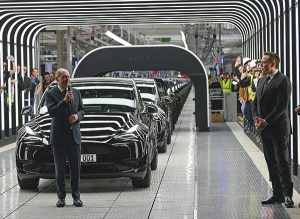Just-in-time manufacturing has become a favourite punching bag during the pandemic supply chain crunch, with critics arguing manufacturers had become too obsessed with efficiency and left themselves too little slack to weather availability constraints or geopolitical disruptions. The terminology is handy because it’s easy for the casual observer to grasp in theory and conjures up images of parts magically appearing at precisely the right moment at all steps of the manufacturing process. In reality, few industrial companies have ever operated to that degree of perfectly coordinated efficiency — although they still aspire to the general idea, even after the lessons of the Covid logjams.
At its core, the concept of just-in-time manufacturing is about building products according to customer demand rather than keeping stockpiles of goods on hand in preparation for when they might be needed. The customer order is the pull that drives every step of the operation, and focusing on that eliminates unnecessary waste that slows productivity, impairs quality and muddies profit margins. When just-in-time works, there’s nothing better. But in its fully realised form, that high degree of synchronization can leave the process at risk for unexpected shocks.
True just-in-time manufacturing is limited to a fairly niche group, however, that mostly consists of automakers such as Toyota Motor Corp, General Motors Co and Ford Motor Co. “When you go to an auto facility — particularly Toyota — what you see on the floor and coming through the door from suppliers is industrial ballet,†General Electric Co Chief Executive Officer Larry Culp said in an interview. “I just don’t think there are a lot of us that have perfected the industrial ballet.â€
That’s partly a reflection of less practice but also the complexity inherent at most diversified industrial manufacturers. Honeywell International Inc, for example, makes everything from airplane engines to ear plugs and scanners for e-commerce warehouses. “I have never believed that for Honeywell it’s such a crucial
capability to have a just-in-time supply chain,†Torsten Pilz, Honeywell’s chief supply chain officer, said in an interview at the company’s headquarters in Charlotte, North Carolina, earlier this month. Honeywell’s complexity can be a challenge “but it’s also a good thing sometimes because if you have a pretty wide array of stuff, you can pivot to different things,†Pilz said.
“It’s not like in the car industry when you have a certain graphics chip, and if you don’t have this
your infotainment for the entire lineup doesn’t work anymore.â€
Many industrial companies practice lean manufacturing, a philosophical umbrella that encompasses the efficiency goals of just-in-time but also seeks continuous improvement in all processes. It’s a holistic ideology that centers on an ultimate goal of delivering better safety performance, higher-quality products, more consistent on-time delivery and lower costs — in that order. The pandemic may inspire some tinkering around the edges on best practices, but it’s unlikely to force a sweeping reevaluation of the basic principles. Efforts such as drilling deeper into the geographical diversity of the supply chain, localising more of the production process or coordinating more closely with parts and raw materials vendors have been framed by critics of “just-in-time†manufacturing as a sign that industry is thinking more in terms of “just-in-case.†But industrial leaders don’t see it that way.
To them, these concepts fit hand in hand with the lean operating ideologies they’ve been preaching for years and their focus on creating value for the customer. They’re not about to drop the steady pursuit of greater productivity in favor of a higher tolerance for slack; quite the opposite in fact. “If we were along our lean journey the way Toyota or others were, maybe recent events would give us more pause,†Culp of GE said. “We can do a better job with our suppliers and rethink geographic footprints, but in terms of the underlying thrust, that can’t possibly change simply because we’re so far away from the ideal.â€
Even for elite just-in-time practitioners, the concept of strategic buffers is far less anathema than one might think. The operating philosophy doesn’t actually work without a cushion somewhere in the system. It’s usually just deep down in the supply chain so it doesn’t weigh on profitability at the top in an obvious way. Parts arrive in a perfectly coordinated fashion at the final assembly plant, but feeder facilities have to keep inventory on hand to enable this choreography. “It’s very flexible for the original equipment manufacturer, but it’s pretty difficult to manage on the supply-base side,†Pilz of Honeywell said.
The nature of these buffers is what’s being reassessed in the wake of
the pandemic disruptions. There’s an impetus toward being more thoughtful and deliberate about where those guardrails exist. That’s quite different from having them for the sake of having them — a reversion to “just-in-case†supply-chains — or debating whether they should exist at all. Honeywell, for example, has redesigned some products to work around chip shortages.
—Bloomberg
Brooke Sutherland is a Bloomberg Opinion columnist covering deals and industrial companies. She previously wrote an M&A column for Bloomberg News
 The Gulf Time Newspaper One of the finest business newspapers in the UAE brought to you by our professional writers and editors.
The Gulf Time Newspaper One of the finest business newspapers in the UAE brought to you by our professional writers and editors.

